Effect of Al Substitution on Structural, Magnetic, and Magnetocaloric Properties of Er6Fe23−xAlx (x = 0 and 3) Intermetallic Compounds
Abstract
:1. Introduction
2. Experimental
3. Results and Discussion
3.1. X-ray Diffraction Results
3.2. Magnetic Properties
3.3. Magnetocaloric Effect
4. Conclusions
Acknowledgments
Author Contributions
Conflicts of Interest
References
- Phejar, M.; Paul-Boncour, V.; Bessais, L. Structural and magnetic properties of magnetocaloric LaFe13–xSix compounds synthesized by high energy ball-milling. Intermetallics 2010, 18, 2301–2307. [Google Scholar] [CrossRef]
- Nouri, K.; Jemmali, M.; Walha, S.; Zehani, K.; Ben Salah, A.; Bessais, L. Structural, atomic Hirschfeld surface, magnetic and magnetocaloric properties of SmNi5 compound. J. Alloys Compd. 2016, 672, 440–448. [Google Scholar] [CrossRef]
- Boutahar, A.; Lassri, H.; Zehani, K.; Bessais, L.; Hlil, E.K. Magneticproperties and magnetocaloriceffect in amorphous Co35Er65ribbon. J. Magn. Magn. Mater. 2014, 369, 92–95. [Google Scholar] [CrossRef]
- Dhahri, A.; Jemmali, M.; Taibi, K.; Dhahri, E.; Hlil, E.K. Structural, magnetic and magnetocaloric properties of La0.7Ca0.2Sr0.1Mn1−xCrxO3 compounds with x = 0, 0.05 and 0.1. J. Alloys Compd. 2015, 618, 488–496. [Google Scholar] [CrossRef]
- Bejar, M.; Dhahri, R.; El Halouani, F.; Dhahri, E. Magnetocaloric effect at room temperature in powder of La0.5(CaSr)0.5MnO3. J. Alloys Compd. 2006, 414, 31–35. [Google Scholar] [CrossRef]
- Triki, M.; Dhahri, R.; Bekri, M.; Dhahri, E.; Valente, M.A. Magnetocaloric effect in composite structures based on ferromagnetic–ferroelectric Pr0.6Sr0.4MnO3/BaTiO3 perovskites. J. Alloys Compd. 2011, 509, 9460–9465. [Google Scholar] [CrossRef]
- Barclay, J.; Oseen-Senda, K.; Skrzypkowski, M. Unique feature of liquefaction of hydrogen and natural. In Proceedings of the 6th IIF-IIR International Conference on Magnetic Refrigeration, Victoria, BC, Canada, 7–10 September 2014; ISBN 9782362150074. [Google Scholar]
- Numazawa, T.; Kamiya, K.; Utaki, T.; Matsumoto, K. Magnetic refrigerator for hydrogen liquefaction. Cryogenics 2014, 62, 185–192. [Google Scholar] [CrossRef]
- Pecharsky, V.K.; Gschneidner, K.A., Jr.; Mudryk, Y.; Paudyal, D. Making the most of the magnetic and lattice entropy changes. J. Magn. Magn. Mater. 2009, 321, 3541–3547. [Google Scholar] [CrossRef]
- Boltich, E.B.; Pourarian, F.; Wallace, W.E.; Smith, H.K.; Malik, S.K. Influence of hydrogen on structure and magnetic properties of Ho6Fe23 and Er6Fe23. Solid State Commun. 1981, 40, 117–120. [Google Scholar] [CrossRef]
- Pedziwiatr, A.T.; Smith, H.K.; Wallace, W.E. Magnetic and structural characteristics of Ho6Fe23 deuterides. J. Solid State Chem. 1983, 47, 41–46. [Google Scholar] [CrossRef]
- Laguna-Marco, M.A.; Chaboy, J.; Maruyama, H. Temperature dependence of the Ho L2,3-edges XMCD spectra in Ho6Fe23. Physica B 2004, 345, 197–200. [Google Scholar] [CrossRef]
- Ouladdiaf, B.; Deportes, J.; Rodriguez-Carvajal, J. Magnetic structures of Er6Mn23 and Dy6Mn23. Physica B 1995, 213, 330–332. [Google Scholar] [CrossRef]
- Delapalme, A.; Deportes, J.; Lemaire, R.; Hardman, K.; James, W.J. Magnetic interactions in R6Mn23 rare earthintermetallics. J. Appl. Phys. 1979, 50, 1987. [Google Scholar] [CrossRef]
- Hardman, K.; James, W.J.; Deportes, J.; Lemaire, R.; de la Bathie, R.P. Magneticproperties of R6Mn23 compounds. J. Phys. Colloq. 1979, 40, C5–C204. [Google Scholar] [CrossRef]
- Buschow, K.H.J.; Sherwood, R.C. Magneticproperties and hydrogen absorption in rare-earthintermetallics of the type RMn2 and R6Mn23. J. Appl. Phys. 1977, 48, 4643. [Google Scholar] [CrossRef]
- Buschow, K.H.J. Magnetic properties of the ternary hydrides of Nd6Mn23 and Sm6Mn23. Solid State Commun. 1981, 40, 207. [Google Scholar] [CrossRef]
- Parker, F.T.; Oesterreicher, H. Analysis of magnetic interactions and structure in R6Mn23. Appl. Phys. A 1982, 27, 65. [Google Scholar] [CrossRef]
- Buschow, K.H.J.; Gubbens, P.C.M.; Ras, W.; van der Kraan, A.M. Magnetization and Mössbauer effect study of Dy6Mn23 and Tm6Mn23 and their ternary hydrides. J. Appl. Phys. 1982, 53, 8329. [Google Scholar] [CrossRef]
- Rietveld, H. A profile refinement method for nuclear and magnetic structures. J. Appl. Crystallogr. 1969, 2, 65. [Google Scholar] [CrossRef]
- Jemmali, M.; Walha, S.; Pasturel, M.; Tougait, O.; Hassen, R.B.; Noël, H. Isothermal section of the Er–Fe–Al ternary system at 800 °C. J. Alloys Compd. 2010, 21, 421–423. [Google Scholar] [CrossRef]
- Krypyakevych, P.I.; Frankevich, D.P.; Voroshilov, Y.V. Compounds with Th6Mn23-type structures in alloys of the rare-earth metals with manganese and iron. Sov. Powder Metall. Met. Ceram. 1965, 4, 915–919. [Google Scholar] [CrossRef]
- Jemmali, M.; Walha, S.; Ben Hassen, R.; Noël, H. Synthesis and Crystal Structure of Er6Fe17.66Al5.34C0.65 Intermetallic Compound. Jpn. Soc. Anal. Chem. 2009, 25, 123–124. [Google Scholar] [CrossRef]
- Lemoine, P.; Verniere, A.; Malaman, B.; Mazet, T. Magnetic and magnetocaloricproperties of Gd6(Mn1−xCox)23 compounds (x ≤ 0.3). J. Alloys Compd. 2016, 680, 612–616. [Google Scholar] [CrossRef]
- Herbst, J.F.; Croat, J.J.; Van Laar, B.; Yelon, W.B. Magnetic structure of Er6Fe23. J. Appl. Phys. 1984, 56, 1224–1226. [Google Scholar] [CrossRef]
- Walha, S.; Jemmali, M.; Skini, R.; Noel, H.; Dhahri, E.; Hassen, R.B.; Hlil, E.K. Structural and Magnetocaloric Properties of ErFe2.4Al0.6 Compound. J. Supercond. Nov. Magn. 2014, 27, 2131–2137. [Google Scholar] [CrossRef]
- Lemoine, P.; Ban, V.; Verniere, A.; Mazet, T.; Malaman, B. Magnetocaloric properties of View the MathML source alloys (x ≤ 0.2). Solid State Commun. 2010, 150, 1556. [Google Scholar] [CrossRef]
- Kirchmayr, H.R.; Steiner, W. Magnetic order of the compound series RE6(MnxFe1-x)23 (RE = Y, Gd). J. Phys. Colloq. 1971, 32, 665–667. [Google Scholar] [CrossRef]
- Wallace, W.E. Rare Earth Intermetallics; Academic Press: Cambridge, MA, USA, 1973; ISBN 9780127328508. [Google Scholar]
- Nagai, H.; Oyama, N.; Ikami, Y.; Yoshie, H.; Tsujimura, A. The Magnetic Properties of Pseudo-Binary Compounds, Gd(Fe1-xMnx)2 and Gd6(Fe1-yMny)23. J. Phys. Soc. Jpn. 1986, 55, 177. [Google Scholar] [CrossRef]
- Nagai, H.; Yokoyama, T.; Katsuyama, S.; Amako, Y.; Yoshie, H.; Adachi, K. The anomalous behaviour of the electrical resistivities of Gd(Fe,Mn)2 and Gd6(Fe,Mn)23. J. Magn. Magn. Mater. 1998, 1131–132, 177–181. [Google Scholar] [CrossRef]
- Pedziwiatr, A.T.; Boltich, E.B.; Wallace, W.E.; Craig, R.S. Magnetic and structural properties of Y6−xErxFe23 alloys and their hydrides. J. Solid State Chem. 1983, 46, 342–348. [Google Scholar] [CrossRef]
- Banerjee, S.K. On a generalised approach to first and second order magnetic transitions. Phys. Lett. 1964, 12, 16. [Google Scholar] [CrossRef]
- Yu, B.F.; Gao, Q.; Zhang, B.; Meng, X.Z. Review on research of room temperature magnetic refrigeration. Chen. Int. J. Refrig. 2003, 26, 622–636. [Google Scholar] [CrossRef]
- Pecharsky, V.K., Jr.; Gschneidner, K. Magnetocaloric effect from indirect measurements: Magnetization and heat capacity. J. Appl. Phys. 1999, 86, 565. [Google Scholar] [CrossRef]
- Gschneider, K.A.; Pecharsky, V.K.; Tsokol, A.O. Recent developments in magnetocaloric materials. Rep. Prog. Phys. 2005, 68, 1479. [Google Scholar] [CrossRef]
- Boutahar, A.; Lassri, H.; Hlil, E.K.; Suprercond, J. Low Temperature Giant Magnetocaloric Effect and Critical Behavior in Amorphous Co100−xErx (x = 55, 65) Alloys. Nov. Magn. 2014, 27, 2865. [Google Scholar] [CrossRef]
- Lemoine, P.; Verniere, A.; Mazet, T.; Magn, B.M. Magnetic and magnetocaloric properties of R6Mn23 (R=Y, Nd, Sm, Gd-Tm, Lu) compounds. J. Magn. Magn. Mater. 2011, 323, 2690–2695. [Google Scholar] [CrossRef]
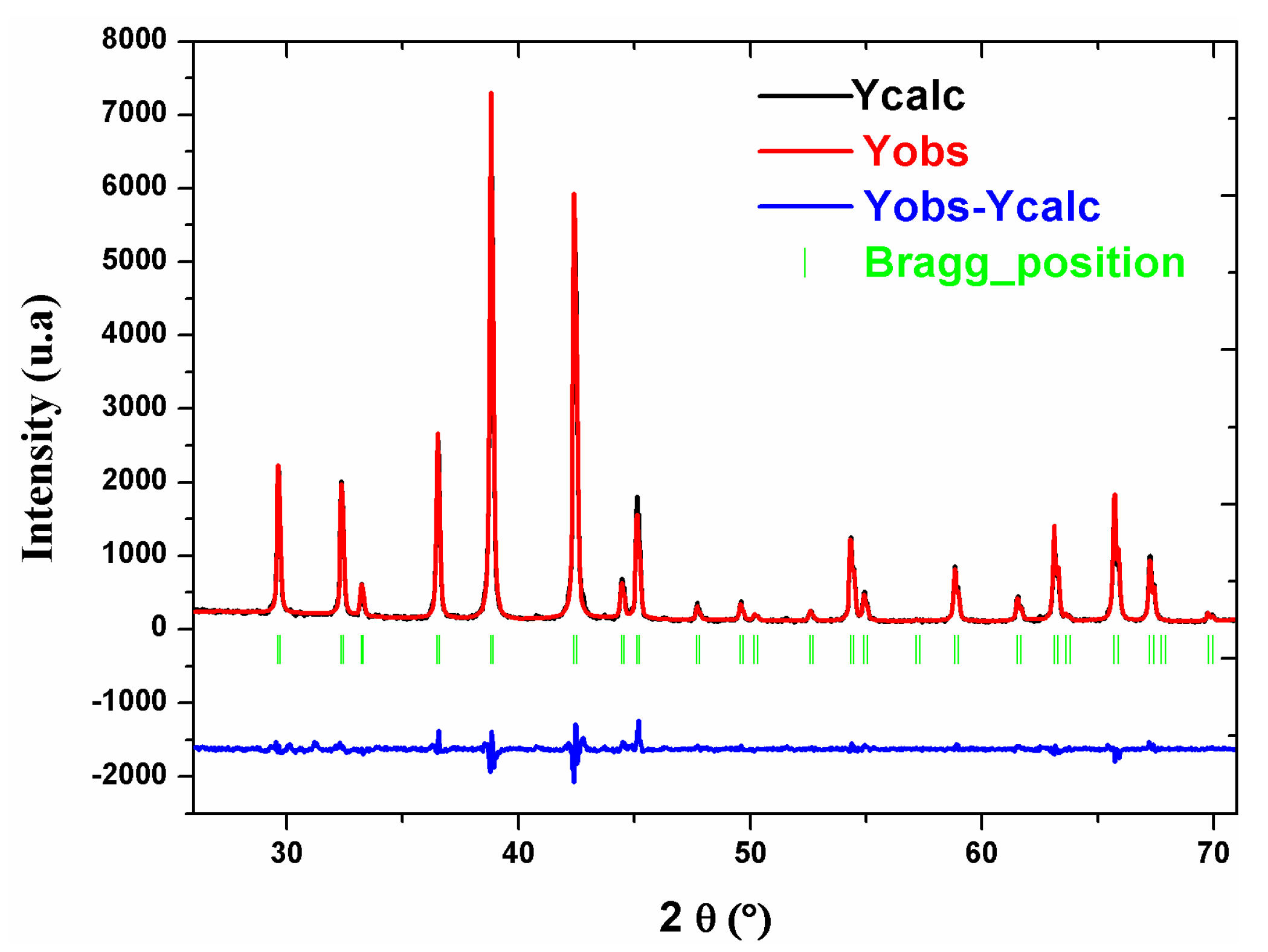
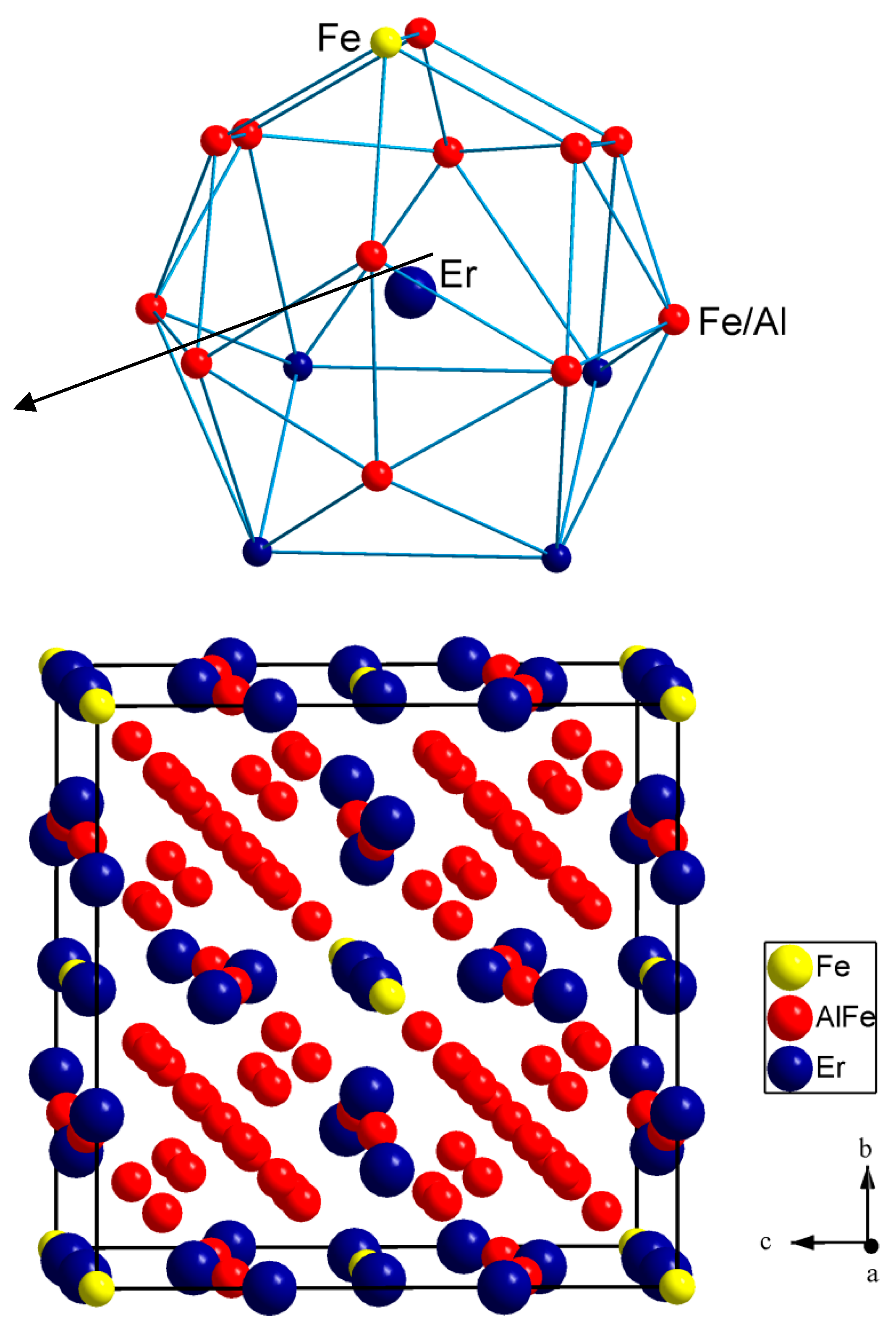
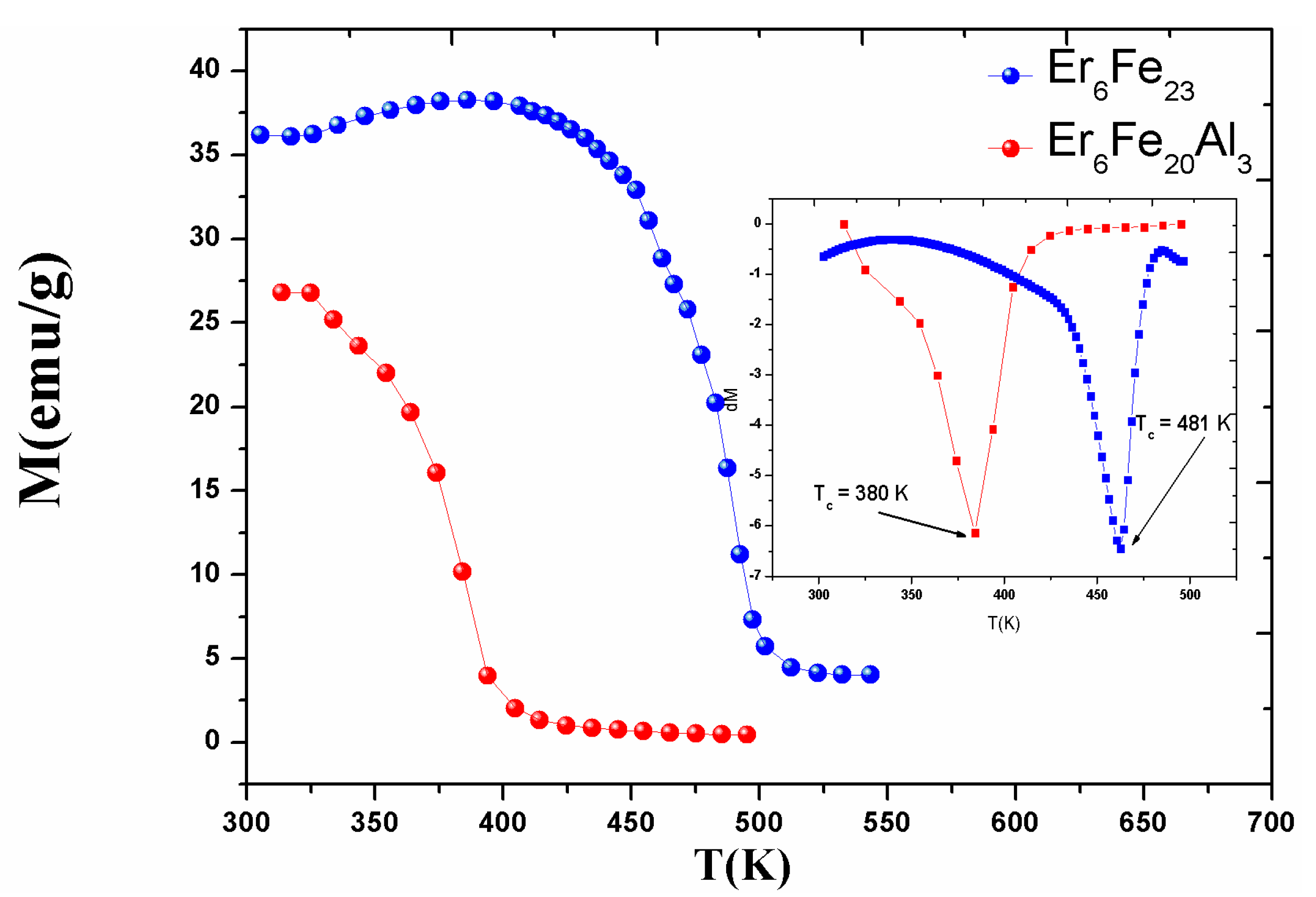

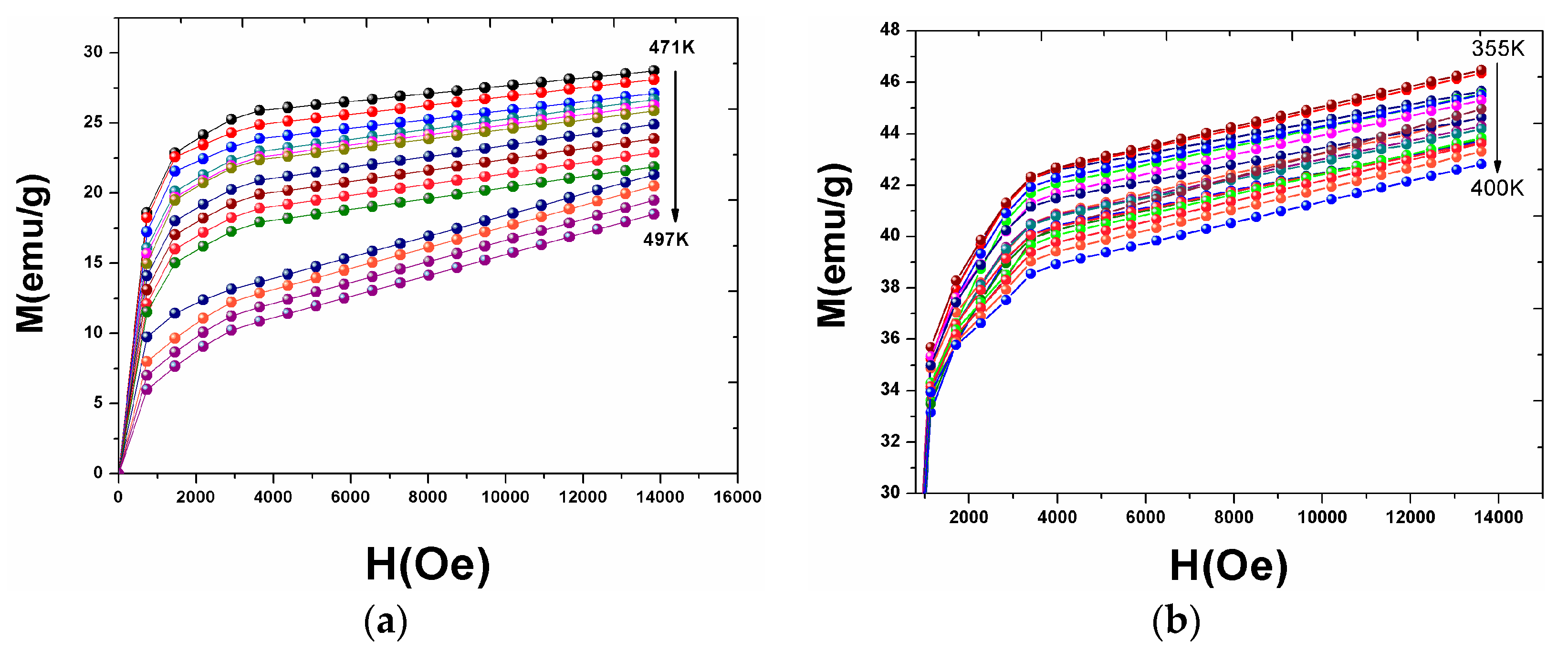

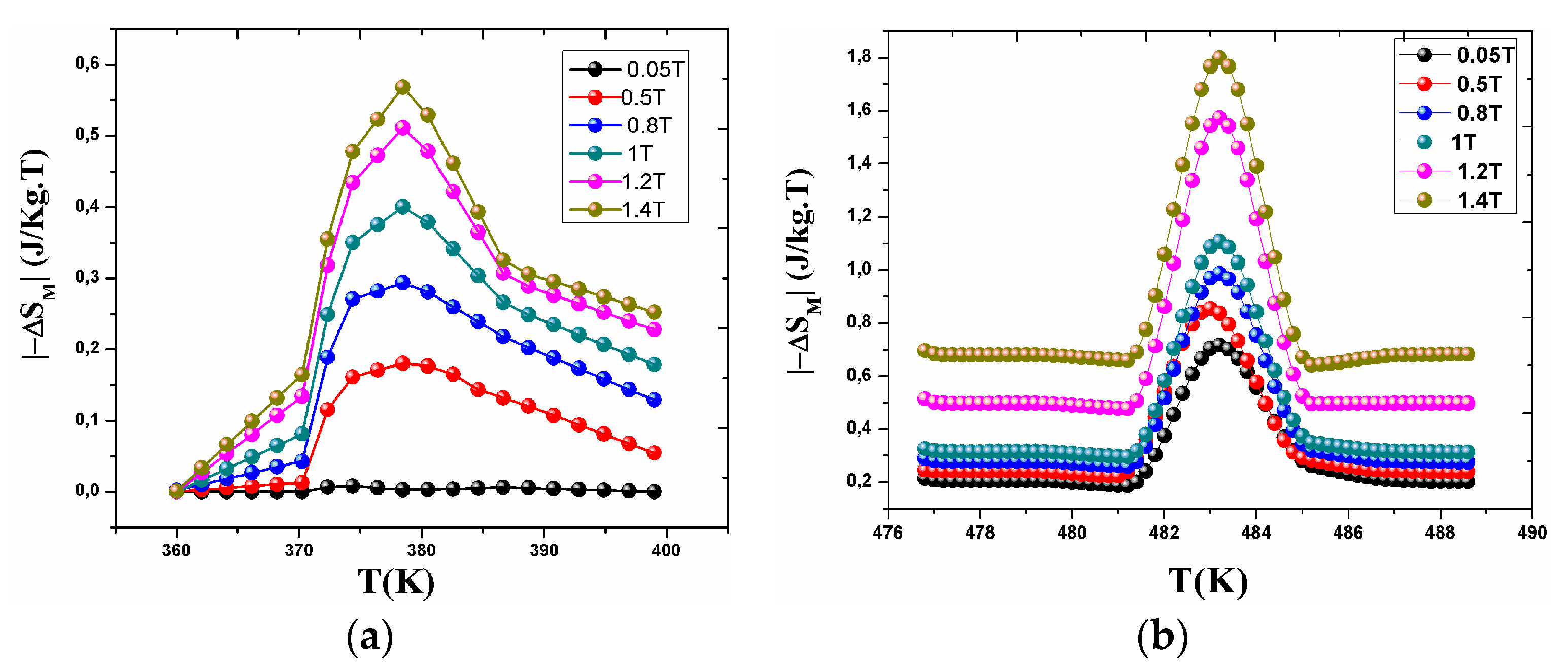
| Compound | Er6Fe20Al3 |
|---|---|
| Type structure | Th6Mn23 |
| Space group | Fm-3m |
| Cell parameters: | |
| A (Å) | 12.0082(2) |
| Volume (Å3) | 1748.91(3) |
| Dcal (g·cm−3) | 7.199 |
| RBragg | 3.21 |
| Rfactor | 2.37 |
| Rp | 6.68 |
| Rwp | 8.58 |
| χ2 = []2 (%) | 2.26 |
| Atoms | Sites | x | y | z | Occ | Ueq |
|---|---|---|---|---|---|---|
| Fe1 | 32f1 | 0.1215(2) | 0.1215(3) | 0.1215(3) | 0.890(2) | 0.037(6) |
| Al1 | 32f1 | 0.1215(2) | 0.1215(3) | 0.1215(3) | 0.091(2) | 0.037(6) |
| Fe2 | 32f2 | 0.3234(2) | 0.3234(2) | 0.3234(2) | 0.880(2) | 0.021(6) |
| Al2 | 32f2 | 0.3234(2) | 0.3234(2) | 0.3234(2) | 0.110(2) | 0.021(6) |
| Fe3 | 24d | 0.00000 | 0.25000 | 0.25000 | 0.740(2) | 0.023(6) |
| Al3 | 24d | 0.00000 | 0.25000 | 0.25000 | 0.259(1) | 0.023(6) |
| Fe4 | 4a | 0.00000 | 0.00000 | 0.00000 | 1.00 | 0.011(5) |
| Er | 24e | 0.2978(2) | 0.00000 | 0.00000 | 1.00 | 0.001(4) |
| Compound | TC (K) | H (kOe) | ΔSM (max) (J/kg·K) | RCP (J/kg) | Reference |
|---|---|---|---|---|---|
| Y6Mn23 | 505 | 50 | 2.1 | - | [38] |
| Nd6Mn23 | 441 | 50 | 2.9 | - | [38] |
| Sm6Mn23 | 456 | 50 | 2.6 | - | [38] |
| Er6Mn23 | 430 | 50 | 34.3 | - | [38] |
| Dy6Mn23 | 447 | 50 | 24.6 | - | [38] |
| Gd6Mn23 | 489 | 10 | 1.6 | - | [38] |
| Gd6(Mn0.875Co0.125)23 | 265 | 10 | 2.4 | - | [38] |
| Gd6(Mn0.85Co0.15)23 | 219 | 10 | 2.9 | - | [38] |
| Er6Fe20Al3 | 481 | 14 | 0.58 | 28 | This work |
| Er6Fe23 | 380 | 14 | 1.8 | 42 | This work |
© 2017 by the authors. Licensee MDPI, Basel, Switzerland. This article is an open access article distributed under the terms and conditions of the Creative Commons Attribution (CC BY) license (http://creativecommons.org/licenses/by/4.0/).
Share and Cite
Jemmali, M.; Alleg, S.; Dhahri, E.; Bessais, L. Effect of Al Substitution on Structural, Magnetic, and Magnetocaloric Properties of Er6Fe23−xAlx (x = 0 and 3) Intermetallic Compounds. Crystals 2017, 7, 156. https://doi.org/10.3390/cryst7060156
Jemmali M, Alleg S, Dhahri E, Bessais L. Effect of Al Substitution on Structural, Magnetic, and Magnetocaloric Properties of Er6Fe23−xAlx (x = 0 and 3) Intermetallic Compounds. Crystals. 2017; 7(6):156. https://doi.org/10.3390/cryst7060156
Chicago/Turabian StyleJemmali, M., S. Alleg, E. Dhahri, and L. Bessais. 2017. "Effect of Al Substitution on Structural, Magnetic, and Magnetocaloric Properties of Er6Fe23−xAlx (x = 0 and 3) Intermetallic Compounds" Crystals 7, no. 6: 156. https://doi.org/10.3390/cryst7060156





